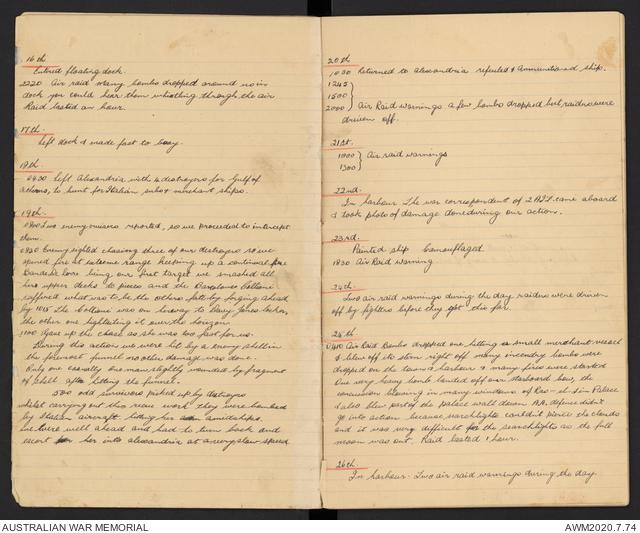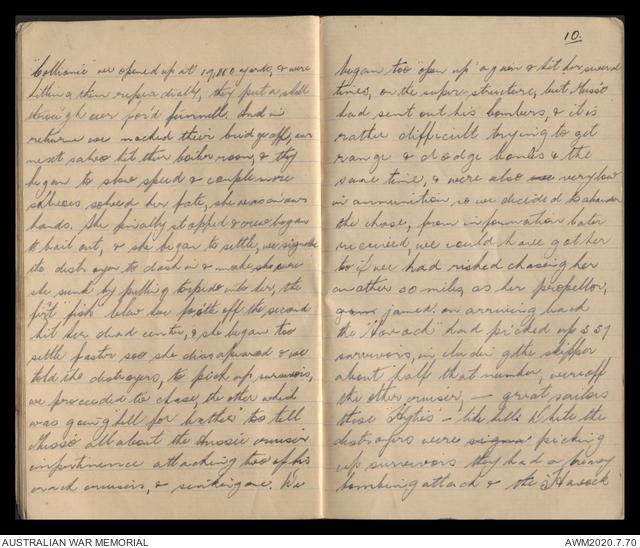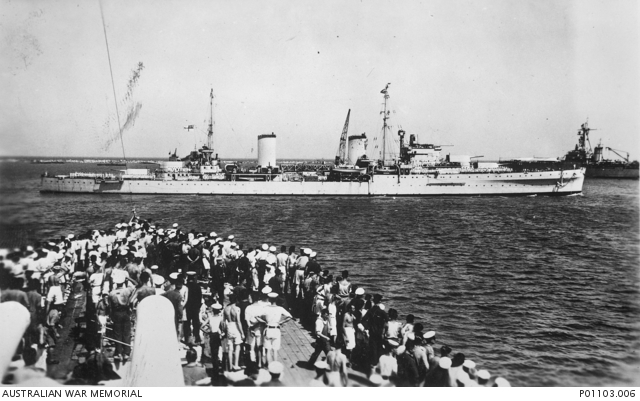Mad Aussies of the Med
“This was the day that we were to be called the crack cruiser of the Med, also the first cruiser to engage two others, sink one by gun fire and badly damage the other, and again to be named the ‘Mad Australians’ by the ‘Kippers’. It happened like this.” (Leonard Doolan Fitzgerald, See Collection Item )
Ships of the Mediterranean fleet at sea, seen from the forecastle of the cruiser HMAS Sydney
This year marks the 80th anniversary of the battle of Cape Spada, the event which made HMAS Sydney (II) and her crew renowned throughout the Mediterranean and the world. On 19 July 1940, Sydney engaged two Italian cruisers, Bartolomeo Colleoni and Giovanni dalle Bande Nere, near the north-western edge of Crete. In an extraordinary show of marksmanship, Sydney succeeded in sinking one ship and severely damaging the other. As well as being published in newspapers far and wide, the event was recorded by many members of the Sydney’s crew, who wrote about their victory in excited tones. In their own words, this is how the day unfolded:
“Our destroyers ahead had reported two enemy cruisers about 40 miles ahead. We increased speed and were told to stand by for action stations at any moment. At 8:15 ‘Action Stations’ sounded off and at 8.25 am enemy was reported in sight.” (Tyler, See Collection Item)
One sailor records the preparations made by the crew:
“We began to spit on our palms and roll up our sleeves, the gun crews stripped to the waist, and we were ready.” (Fitzgerald, See Collection Item)
Upon sighting the Italian cruisers, the first shots were fired:

Wallet 1 of 1 - Diary of John Foster Roy Primmer, 1940-1941, AWM2020.7.74
“0830 Enemy sighted chasing three of our destroyers so we opened fire at extreme range keeping up a continual fire.” (Primmer, See Collection Item)
”This was the most critical stage of all in my opinion, had we faltered at all and turned away it would have given them a sense of security. However our Captain J.A. Collins RAN took the bull by the horns and altered course straight to the enemy ships.” (Triggs, See Collection Item)
“They must have thought we were easy pickings until our 6” started blaring.” (Walker, See Collection Item)
“We opened fire on the leading ship at extreme range, 22,000 yards and reduced it to 19,000. A couple of salvos were seen to strike it, but it turned away and was out of range again. We then shifted to the second cruiser and almost immediately began to hit it.” (Pascoe, See Collection Item)
It was not long before the enemy ships were severely damaged:
Italian Cruiser Bartolomeo Colleoni on fire and surrounded by shell splashes
“We had been hitting her all the time at extreme range, and now the range-takers were having the time of their life.” (Tyler, See Collection Item)
“The punishment became too severe for the ‘Bandi Nere’ and at 8:47 Colleoni crossed her stern and laid a smoke screen. This act sealed her own doom. As soon as the ‘Bandi Nere’ became obscured we changed our target to the ‘Colleoni’ and started to hit her immediately. It was magnificent gunnery, the first broadside straddled the ‘Colleoni’, the second found its mark, and every broadside after that.” (Triggs, See Collection Item)
“Our first few well aimed salvos reached their target thus apparently reducing their speed for it was not long after we made chase that they were within range and so a few more well aimed salvos reached the target causing much damage to her until finally they had stopped, which allowed us to score direct hits upon her, thus rendering her useless amidst smoke and flames.” (Scudd, See Collection Item)
Although Bartolomeo Colleoni had put up a good fight, she had been damaged so acutely that she began to sink:
A cloud of smoke from the Italian cruiser Bartolomeo Colleoni as she goes down
“… bits are flying everywhere from her, she seems just about jiggered, and is nearly stopped, completely out of control, but is still firing.” (Evans, See Collection Item)
“At 0920 ‘Colleoni’ was hit in a vital spot and lost way completely. Her guns were then silenced and she started on her last trip downwards.”(Triggs, See Collection Item)
“She finally stopped and crew began to bail out, and she began to settle, we signaled the destroyer to dash in and make sure she sunk by putting a torpedo into her, the first fish blew her fo’stle off, the second hit her dead center, and she began to settle faster.” (Fitzgerald, See Collection Item)
“… we noticed that the destroyers had put a couple of ‘tin-fish’ into the now silenced enemy we had left, and with a terrific explosion she gently keeled over and sank.” (Tyler, See Collection Item)
While Bartolomeo Colleoni was sinking, Giovanni dalle Bande Nere used her superior speed to make a getaway:
“By 1015 the Colleoni was on her way to Davy Jones locker, the other one hightailing it over the horizon.” (Primmer, See Collection Item)
“… we proceeded to chase the other which was going ‘hell for leather’ to tell Musso’ all about the Aussie cruiser impertinent attacking two of his crack cruisers, and sinking one. We began to ‘open up’ again and hit her several times, on the super-structure, but Musso’ had sent out his bombers, and it is rather difficult trying to get range and dodge bombs at the same time, and were also very low in ammunition so we decided to abandon the chase.” (Fitzgerald, See Collection Item)
“… she would not take us as even odds, and departed in a hurry with our salvos bursting after her. It was impossible to catch her.” (Tyler, See Collection Item)
Meanwhile, the Sydney’s accompanying destroyers were picking up survivors from the sea:
“500 odd survivors picked up by destroyers whilst carrying out this rescue work they were bombed by Italian aircraft, hitting her amidships.” (Primmer, See Collection Item)
“Whilst the destroyers were picking up survivors, they were heavily bombed by enemy air-craft, and one bomb hit the ‘Havoc’ right in her side and the beam. The water-tight doors were closed, and kept a speed of 20 knots, with her pumps working overtime. The survivors, when checked, numbered 545, nearly all of the cruiser’s crew.”(Tyler, See Collection Item)
Incredibly, although the Sydney was under near-constant shell-fire, very little damage was sustained. Additionally, there was only one minor casualty from her crew:
Only casualty in the successful action against the Italian cruiser Bartolomeo Colleoni
Unidentified Australian sailors inspecting the damage caused to HMAS Sydney II
“All this time both ships had been firing on us and although they were a little erratic they were straddling us two out of three salvos. They hadn’t gained any hits but splinters of shrapnel were falling on our deck. At 0917 ‘Colleoni’ got her one and only hit on us, the shell struck our foremost funnel and blew a hole about four feet in diameter in it. One of our Torpedo Party by the name of D Thompson was hit on the shoulder by a piece of shrapnel. It made a nasty little hole but it wasn’t serious, he remained at his port until ordered to Sick Bay.” (Triggs, See Collection Item)
News of the victory spread quickly throughout the area. Upon returning to her harbour in Alexandria, Egypt, the following day, the Sydney was met with cheers and ceremony:
A crowd watches the triumphant return of HMAS Sydney to Alexandria Harbour
“… we were given pride and position and came into harbour first. There was a marvelous reception waiting for us. All the Battle Fleet lined up and manned ship as we slowly steamed down the long line. Every ship cheered us from the biggest battleship to the smallest craft. Those to make the most noise were our own destroyers who could hardly be seen for Australian Flags flying at the masthead.” (Triggs, See Collection Item)
Smaller celebrations were held on board the ship:
“It was piped before we fell out ‘all hands will be given an extra ration of butter for dinner today’.” (Tyler, See Collection Item)
This action against the Italian cruisers Bartolomeo Colleoni and Giovanni dalle Bande Nere was a defining moment for the crew of the Sydney. It was this action which the crew earned their reputation as brave and gallant sailors, and earned their nickname, the “Mad Australians”.

Wallet 1 of 1 - Diary of Leonard Doolan Fitzgerald, 1940-1941, AWM2020.7.70
“The C&C [Commander in Chief] said that when he received our wireless message that we were going to attack, he sat back and said to his batman ‘those mad Aussies will do it, if anyone would’.” (Fitzgerald, See Collection Item)
Sadly, many of Sydney’s crew who served in the Mediterranean died in November 1941, after action with the German raider Kormoran.






